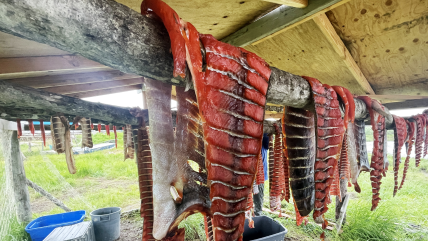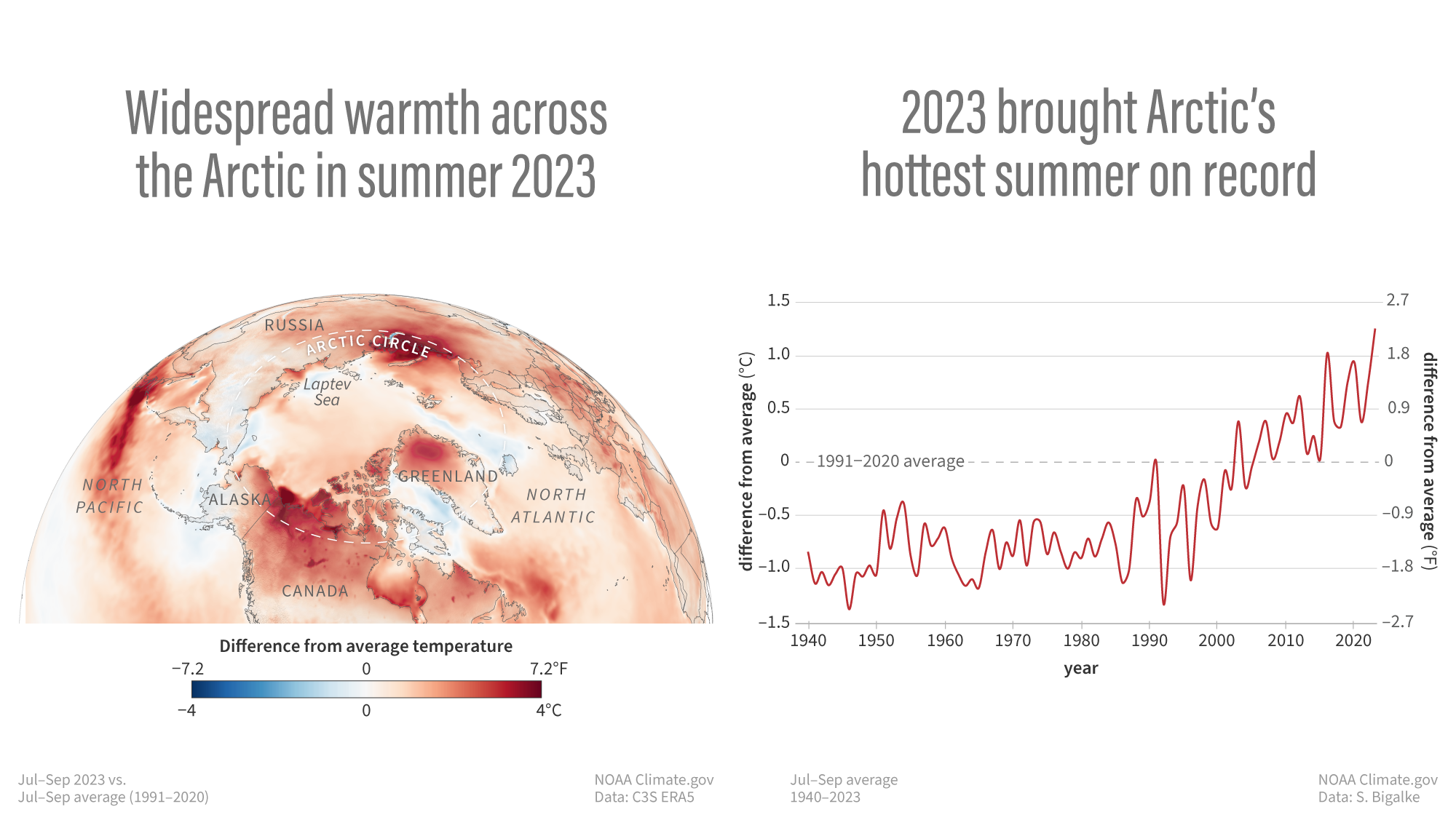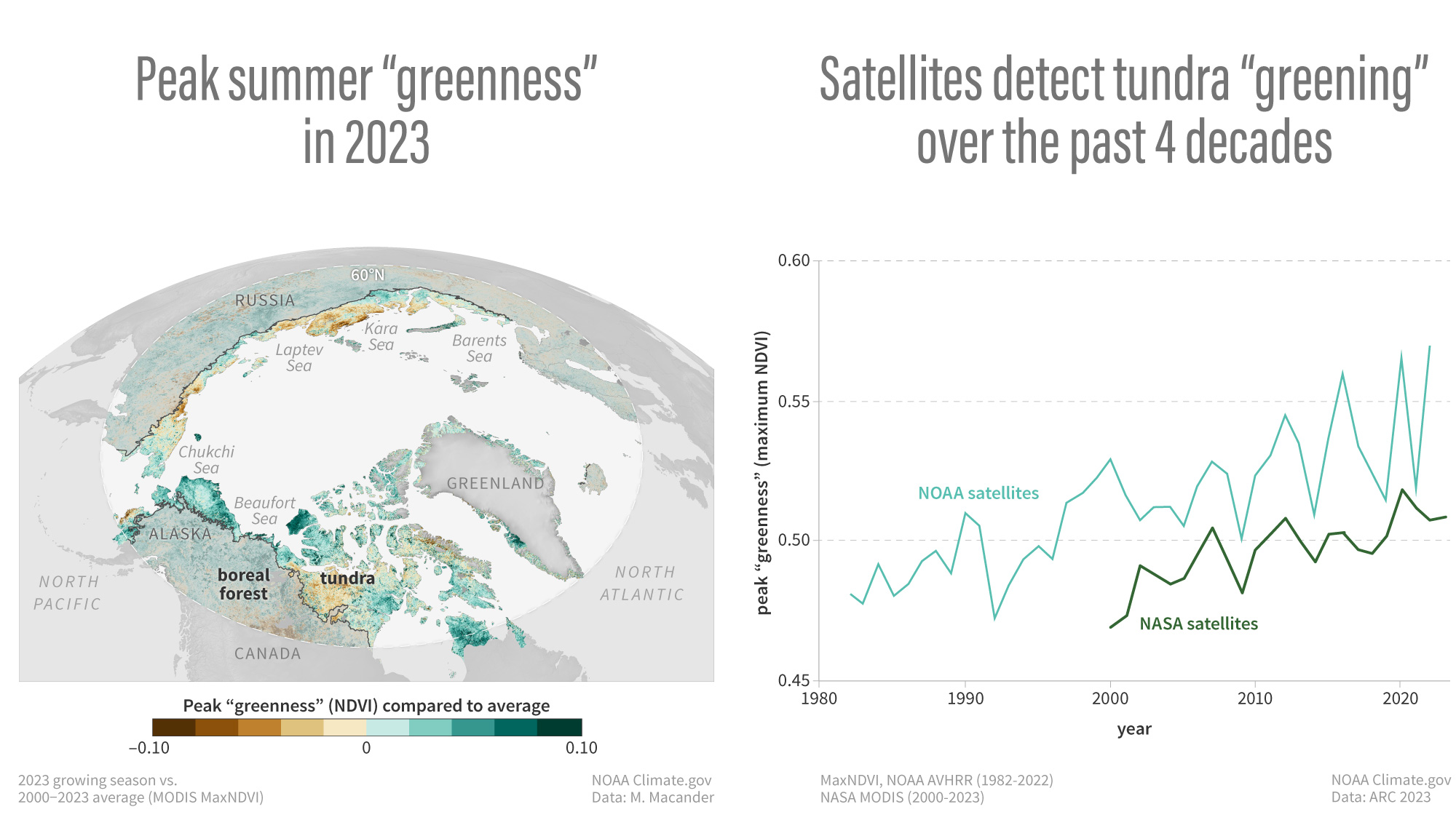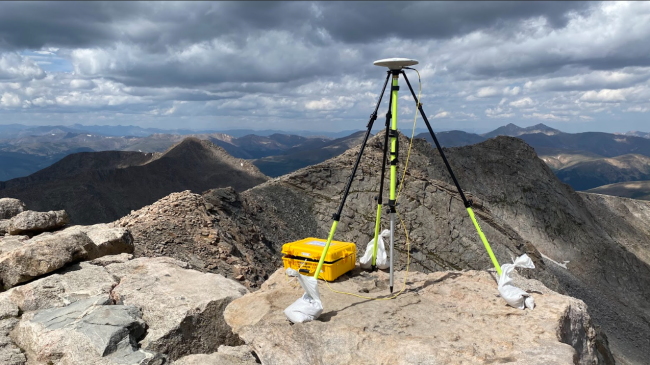New chapters in 2023 Arctic Report Card show the promise of Indigenous knowledge to strengthen resilience

Guy Omnik observing the sea ice near Point Hope, Alaska, in January 2020 as part of the Alaska Arctic Observatory and Knowledge Hub. (Image credit: Caroline Nashookpuk)
NOAA’s 2023 Arctic Report Card documents new records showing that human-caused warming of the air, ocean and land is affecting people, ecosystems and communities across the Arctic region, which is heating up faster than any other part of the world.
Summer surface air temperatures during 2023 were the warmest ever observed in the Arctic, while the highest point on Greenland’s ice sheet experienced melting for only the fifth time in the 34-year record. Overall, it was the Arctic’s sixth-warmest year on record. Sea ice extent continued to decline, with the last 17 Septembers now registering as the lowest on record. These records followed two years when unprecedented high abundance of sockeye salmon in western Alaska’s Bristol Bay contrasted with record-low Chinook and chum salmon that led to fishery closures on the Yukon River and other Bering Sea tributaries.
“The overriding message from this year’s report card is that the time for action is now,” said Rick Spinrad, Ph.D., NOAA administrator. “NOAA and our federal partners have ramped up our support and collaboration with state, tribal and local communities to help build climate resilience. At the same time, we as a nation and global community must dramatically reduce greenhouse gas emissions that are driving these changes.”
The annual Arctic Report Card, now in its 18th year, is the work of 82 authors from 13 countries. It includes a section titled Vital Signs, that updates eight measures of physical and biological changes, four chapters on emerging issues and a special report on the 2023 summer of extreme wildfires.

Divergent climate impacts on salmon fisheries
One new chapter in the report focuses on salmon species that are vital to the health, cultures and food security of many Indigenous communities as well as to commercial fishing economies. During 2021 and 2022, sockeye salmon, a staple of commercial fishing, reached record-high abundance in Bristol Bay, Alaska, while Chinook and chum salmon, fished by Indigenous communities in the Yukon and Kuskokwim rivers, fell to record-low abundance. Declining fisheries have continued into 2023 with fishing closures.
Chinook and chum salmon numbers have declined following recent heatwaves and ecosystem changes in the rivers where they spawn and the ocean waters where they grow to maturity. Warming river waters have been linked to heat stress in Chinook salmon, and warmer ocean waters may be contributing to both species maturing as smaller adults.
Contrastingly, sockeye have been extremely successful under recent warm conditions, which allow them to grow faster in lakes as juveniles and may boost their survival when they migrate to the ocean. The diverging impacts are affecting Indigenous communities that depend on the salmon for food, and challenging fishery managers as the different species respond in unique ways to the warming climate.
Indigenous knowledge strengthens science and resilience
The 2023 report card features two chapters on the importance of implementing Indigenous knowledge for the future resilience of the Arctic. One chapter describes the work of the Alaska Arctic Observatory and Knowledge Hub offsite link, a collaboration between University of Alaska scientists and a network of Iñupiaq observers who are documenting long-term environmental change and social and cultural impacts on their northern Alaska communities.
The value of Indigenous and local knowledge to help tackle environmental challenges is also central to a chapter on the restoration of peatlands and boreal forests in Finland, where Indigenous Sámi people and Finnish villages are working with scientists to restore these wetland ecosystems and forests.
Over the last two decades, the Finnish nonprofit Snowchange Cooperative offsite link has restored dozens of sites, positively influencing 128,000 acres (52,000 hectares) of peatlands and forest damaged by decades of industrial harvesting and forest management. The restoration demonstrates a globally relevant climate solution that increases carbon storage, preventing greenhouse gas emissions from entering the atmosphere. The restored peatlands are also restoring water quality and bringing back fish and birds, a vital food source and draw for ecotourism.
Another new chapter delves into the little-known topic of subsea permafrost, a potential source of greenhouse gas emissions. For thousands of years as the world emerged from the last ice age, rising ocean waters in the Arctic continued to cover more and more permafrost, transforming it into subsea permafrost. The Arctic has an estimated 965,000 square miles of subsea permafrost, a fifth of the amount of permafrost found on land. International research collaboration is needed to address questions about the extent and current state of subsea permafrost and to estimate the potential release of greenhouse gases as it thaws.
Major annual updates of Vital Signs for 2023

The average surface air temperature in the Arctic this past year was the sixth warmest since 1900 at 20 degrees Fahrenheit (-7 Celsius). The summer Arctic average temperature was the warmest on record at 43 degrees Fahrenheit (6.4 Celsius). Data shows that since 1940, annual average temperatures have risen .45 of a degree Fahrenheit (.25 of a degree Celsius) per decade and average summer temperatures have risen .31 of a degree Fahrenheit (.17 of a degree Celsius) per decade.
Sea ice extent continues to decline, with the 17 lowest Arctic sea ice extents on record occurring during the last 17 years. This year’s sea ice extent was the sixth lowest in the satellite record, which began in 1979, with older, thicker multi-year ice far less than in the 1980s.
Mean sea surface temperatures in August 2023 were 9 to 13 degrees Fahrenheit (5-7 degrees Celsius) warmer than the 1991-2020 August mean values in the Barents, Kara, Laptev and Beaufort seas. Unusually cool August temperatures were observed in Baffin Bay, Greenland Sea and parts of the Chukchi Sea. August mean sea surface temperatures show warming trends for the period from 1982 to 2023 in areas of the Arctic Ocean that are ice free in August, with mean sea surface temperature increases of nearly a degree Fahrenheit (.5 of a degree Celsius) per decade.
Arctic Ocean regions, except for the Canadian Archipelago, Chukchi and Beaufort seas, continue to show increased ocean phytoplankton blooms, or primary productivity, with the largest percent increases in Eurasian Arctic and Barents Sea.
North American snow cover set a record low in May 2023, while snow accumulation during the 2022-2023 winter was above average across both North America and Eurasia.
Heavy precipitation events broke existing records at various locations across the Arctic, with some variation such as a dry summer in northern Canada, contributing to record wildfires. Pan-Arctic precipitation was the sixth highest on record, continuing the trend toward a wetter Arctic.

Tundra greenness across the Arctic was the third highest in the 24-year satellite record, a slight increase over 2022. The Arctic continues a trend of increased shrubs, willows and alders where once there was tundra.
The Greenland Ice Sheet continued to lose mass despite above-average winter snow accumulation. Summit Station, the highest point on the ice sheet, reached a temperature of 32.7 degrees Fahrenheit on June 26, 2023, experiencing melting for only the fifth time in the 34-year record.
For more information, please see the Arctic Report Card and a short video summarizing main highlights from the report card.
Media contacts
Monica Allen, monica.allen@noaa.gov, (202) 379-6693
Theo Stein, theo.stein@noaa.gov, (303) 819-7409


